Edd Hopkinson
Senior Designer
Vodafone Design Language
Creating a foundational design framework to align design teams, improve design system alignment, and drive consistency.
Research
Strategy
Direction
Design System
Design
Guidance
Completed @ Vodafone
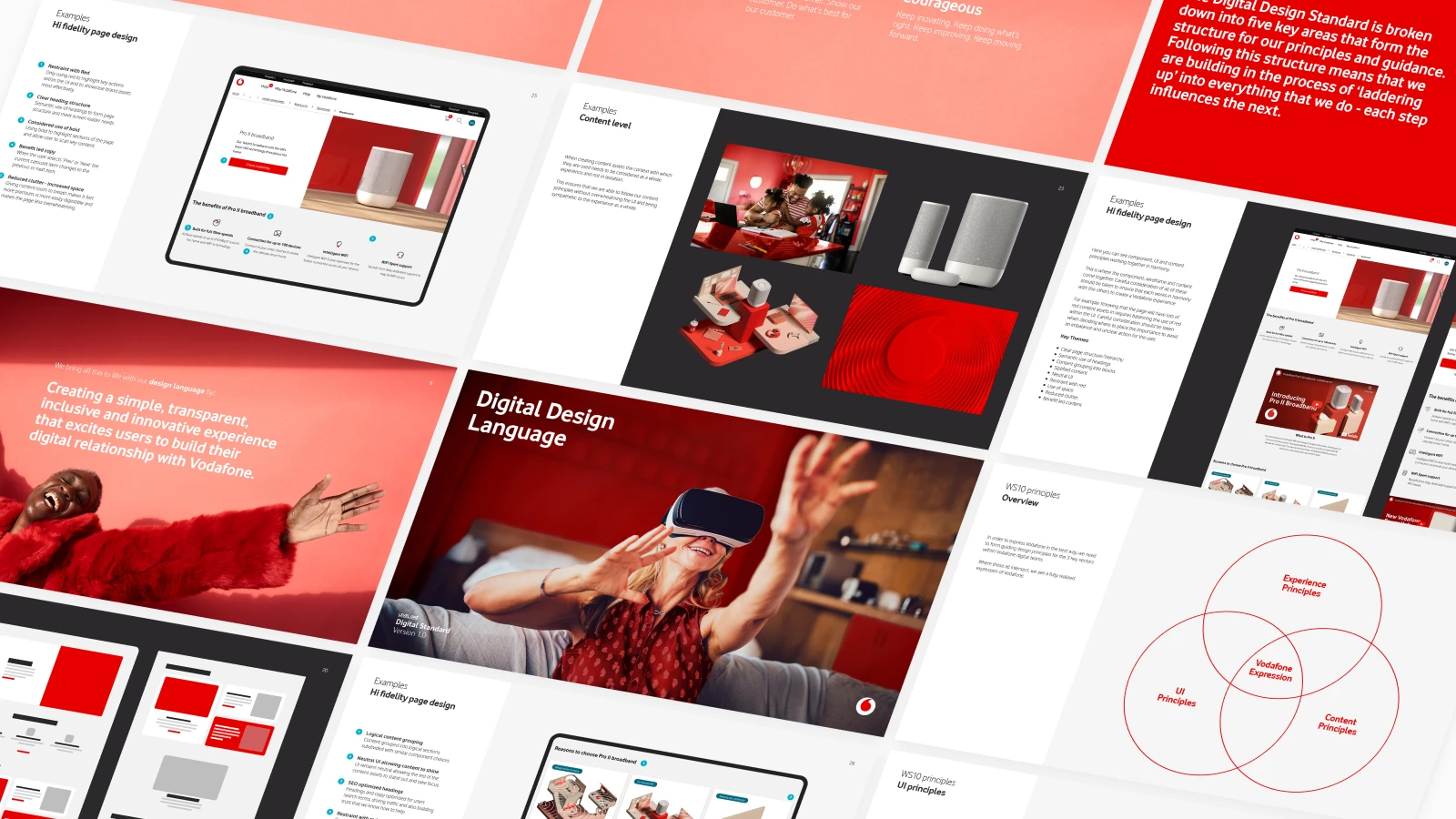
Outcomes
Integrated brand, UX/UI, and content into a single framework
Connected design to business goals
Source of truth for design decisions
Clear guidance for design system use
Improved design consistency across teams
Foundational for DesignOps inititives
Challenge
Vodafone UK inherited an incomplete design system with minimal documentation, poor digital guidance, and brand principles built primarily for print and above-the-line.
This led digital teams to implement the design system in their own ways, leading to inconsistent experiences and misaligned journeys.
Objectives
Define a cohesive design language to align design teams to a shared vision; bridging brand, strategy, UX/UI, and content into a consistent, scalable system.
Take a look at the complete design language
See the design language
Defining the vision
I collaborated with the Design Language team to develop a clear, actionable vision statement to act as a north star for decision making.
View the vision statement workshop
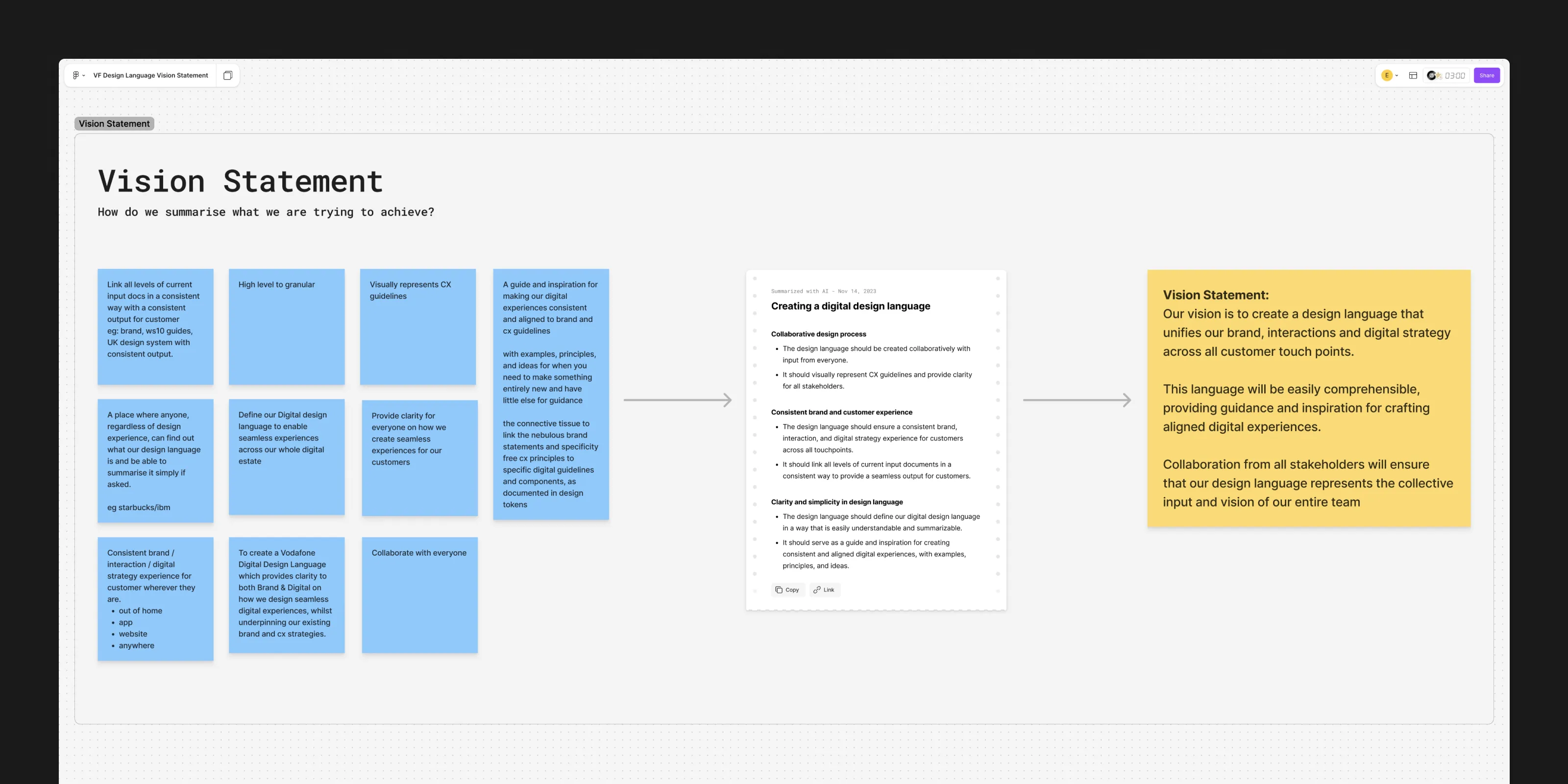
Setting goals
Goals were workshopped with UX/UI, Content Design, and Design System teams. These were refined into six goals that the design language needed to achieve to meet the project objectives.
See the goals workshop
Reference for design decisions
Help designers understand design decisions, ensuring consistency and coherence.
Seamless alignment across teams
Align all digital teams, streamlining workflows, and ensuring that everyone can apply the language with minimal training.
Identifying misalignment in designs
Users should be able to easily identify misalignment in their designs.
Specific and well-illustrated guidance
Clear, specific guidance with examples to gain confidence in decision making knowing that every step is well-supported.
Alignment of needs
Streamline the approval process by reducing conflicting component needs or competing priorities enabling faster delivery.
Consistency across platforms
By ensuring consistency we can impact key metrics such as click-through rates, conversion rates, and Net Promoter Score.
Research
I analysed existing brand strategies, employee goals, principles, guidelines, and documentation. This exposed gaps and misalignment; highlighting the lack of digital-specific guidance connecting brand, UX/UI, and content design.
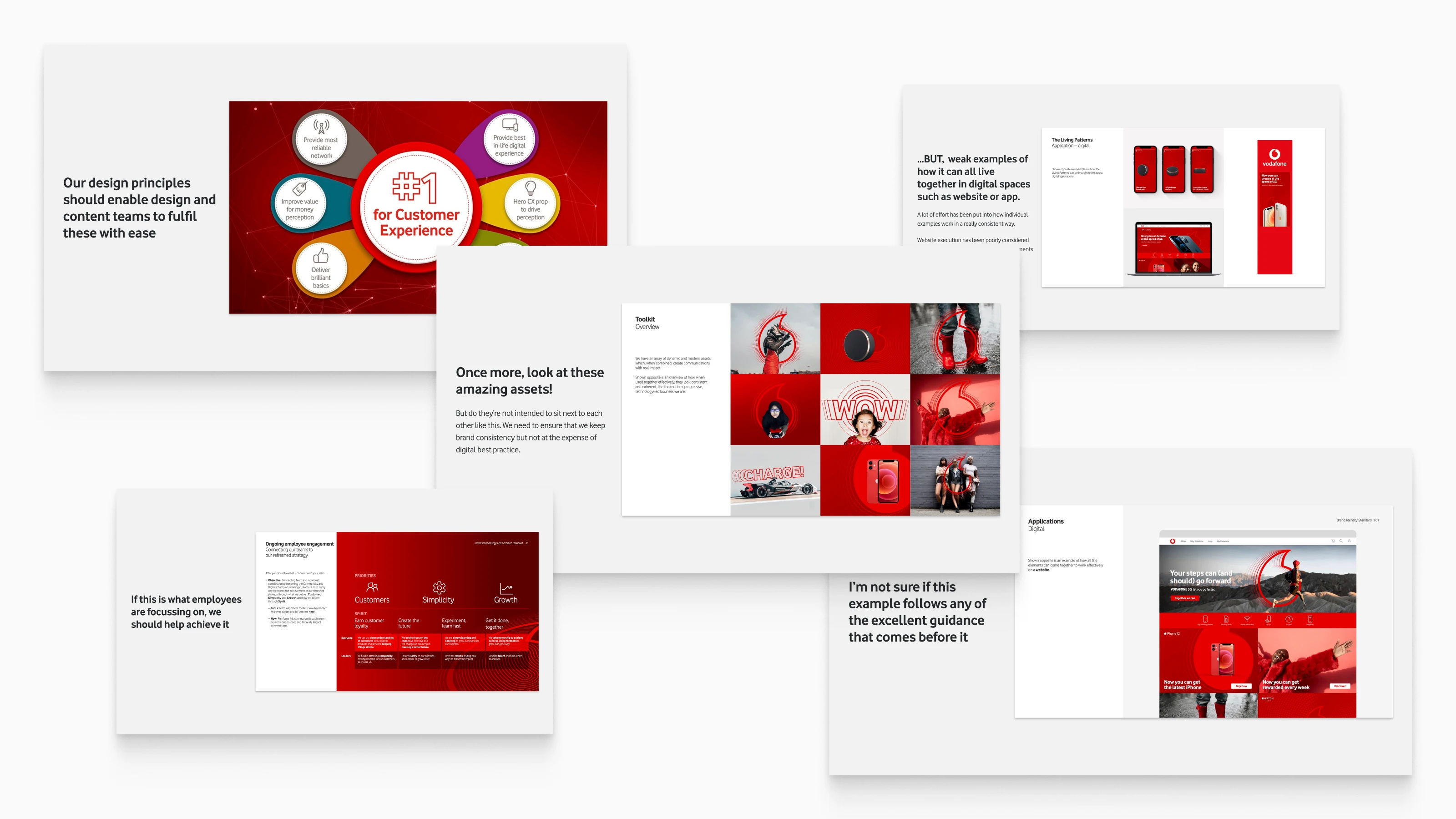
Research insights:
Disconnected goals
Business goals seemed unrelated and unachievable to design roles. How could a designer help?
Poor brand integration
Design system lacked specific integration of brand principles and guidance.
Lack of awareness
Teams were not always aware of guidance or documentation, or where to go for help.
Poor brand guidance
Predominantly non-digital leading teams to form their own interpretation of the brand in digital.
Siloed teams
Teams were working in isolation, leading to inconsistent design patterns for customers.
Misalignment
Teams were free to use the design system unguided, leading to inconsistent experiences.
Creating the design language
Following the research phase I created a foundational design language to align design teams to a shared vision; bridging brand, strategy, UX/UI, and content into a consistent, scalable system.
The design language links four key areas together:
Business goals
Design principles
Design guidance
Design examples
Business goals
Brand, digital, and experience goals mapped into one framework
I consolidated brand ambition, digital mission, and experience principles to give design teams a clear view of how their digital specific team goals and work help achieve wider business and brand objectives — making wider objectives more relevant day-to-day and making them feel achievable.
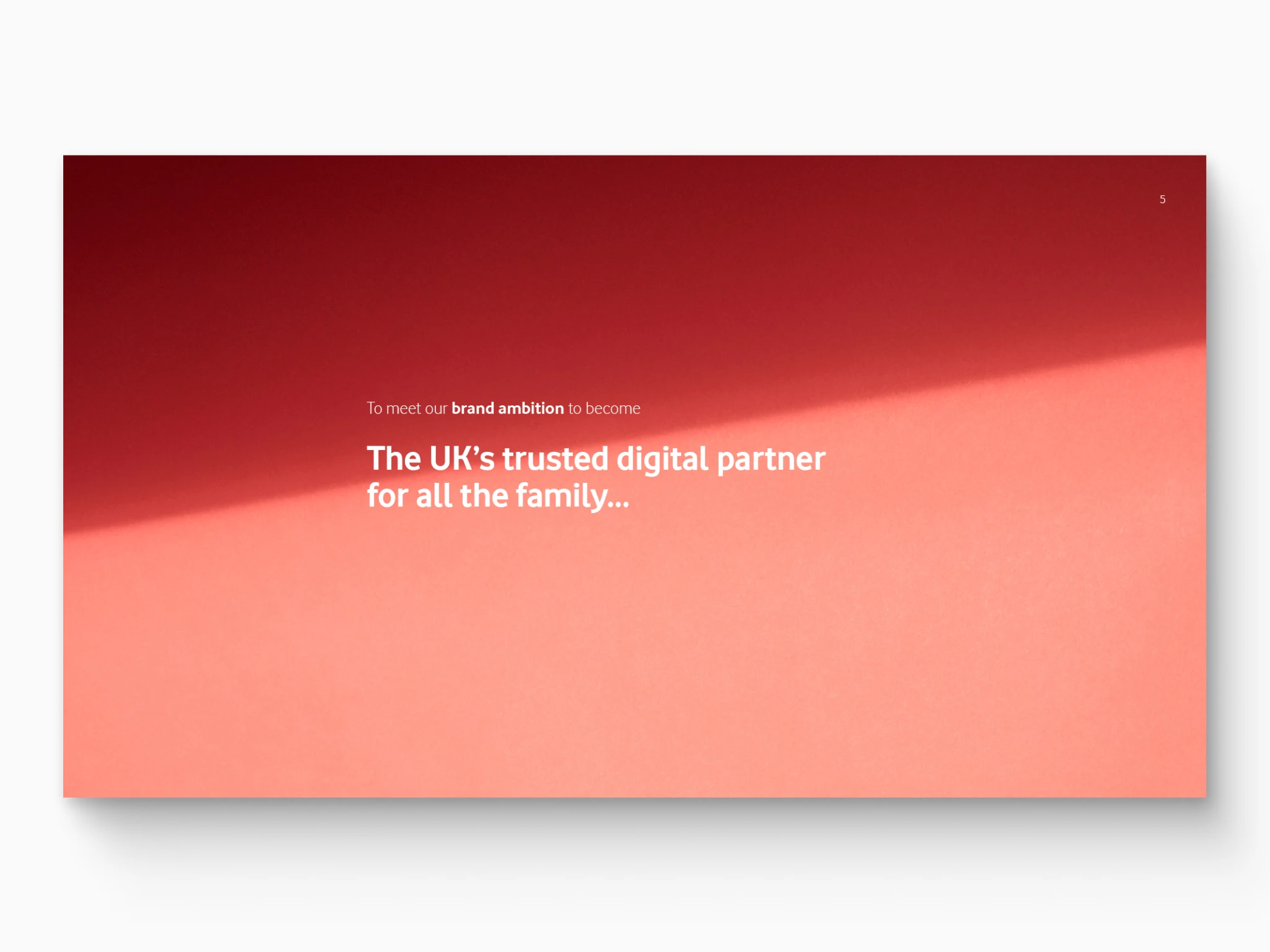
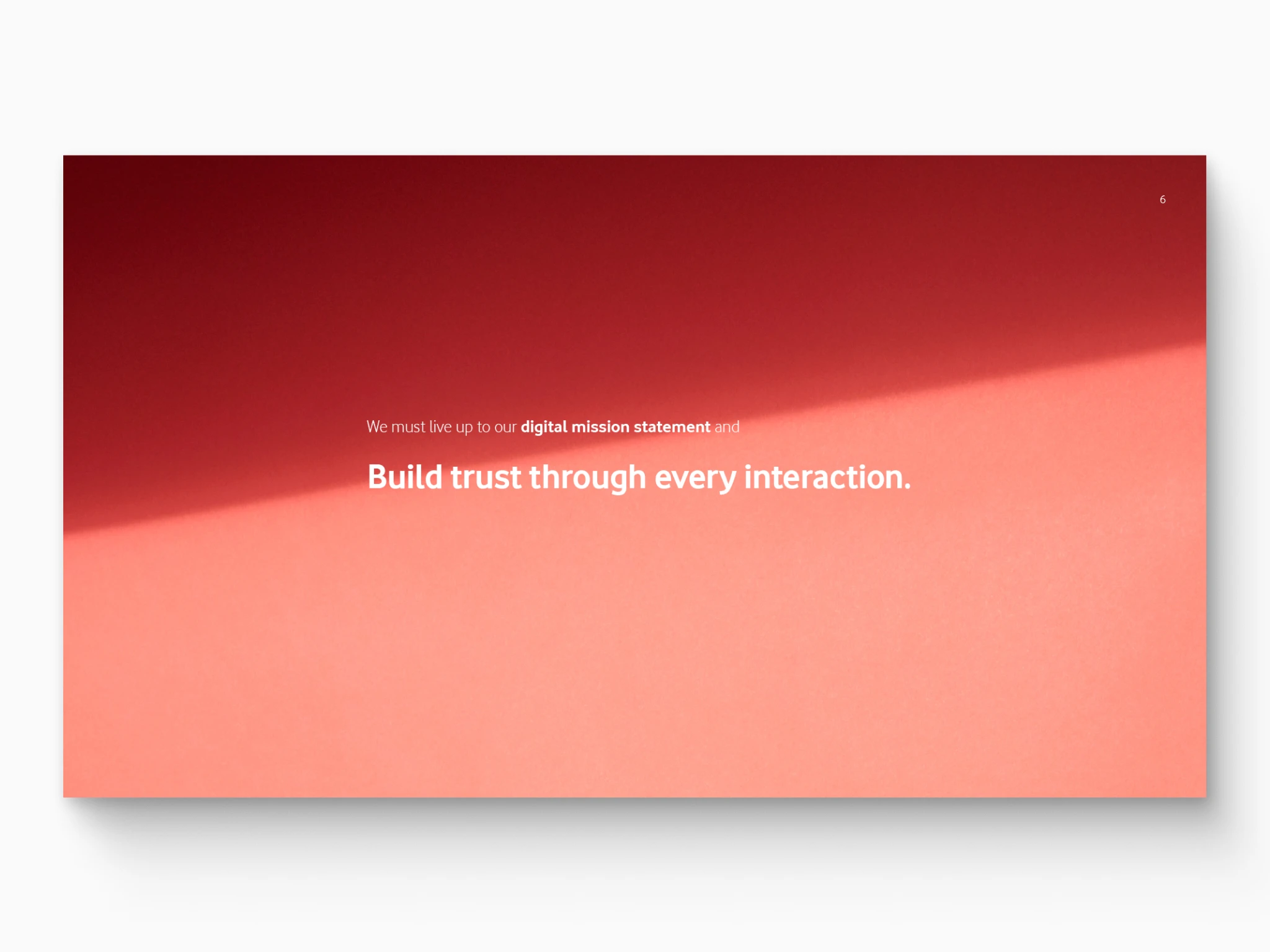
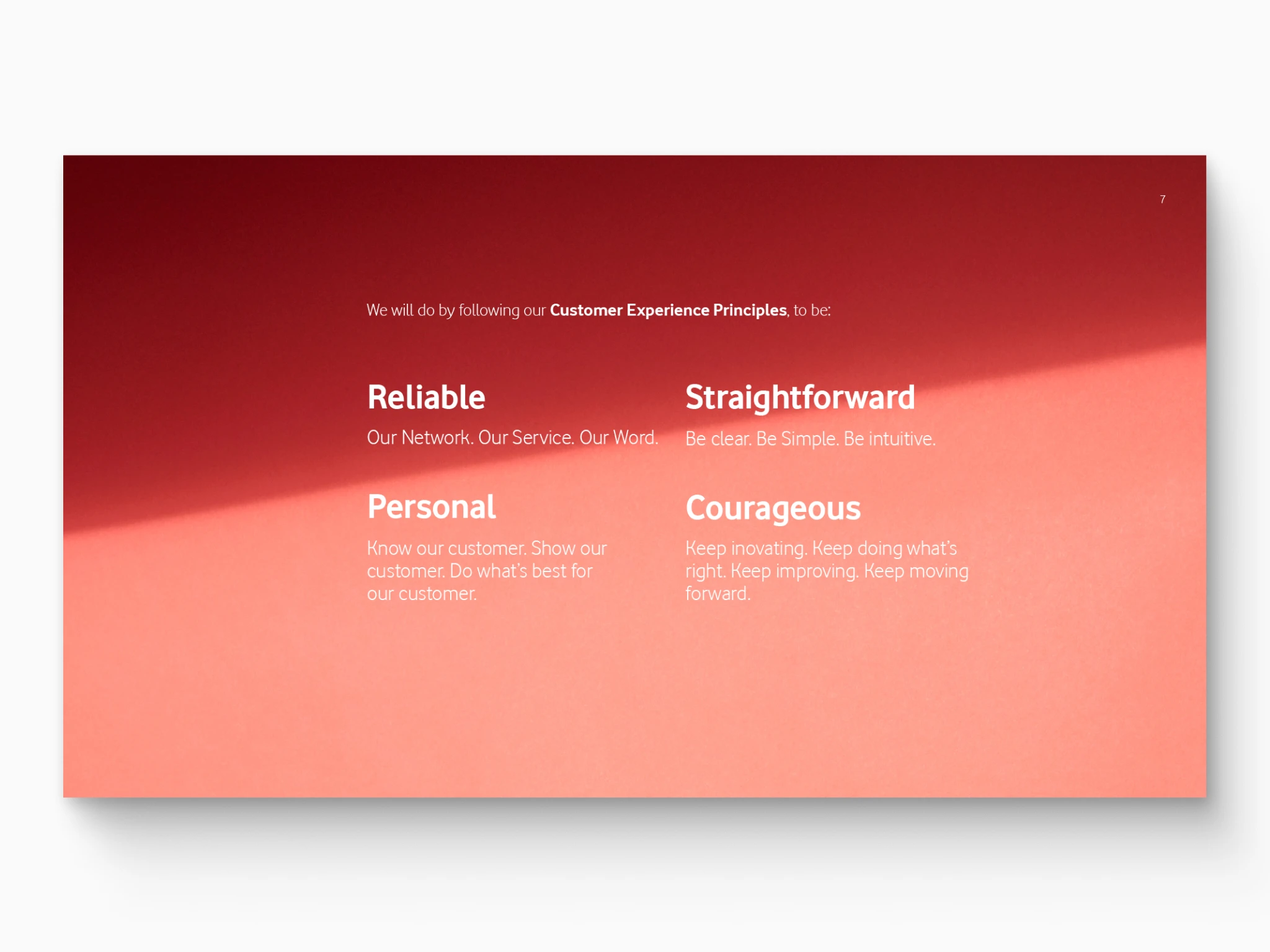
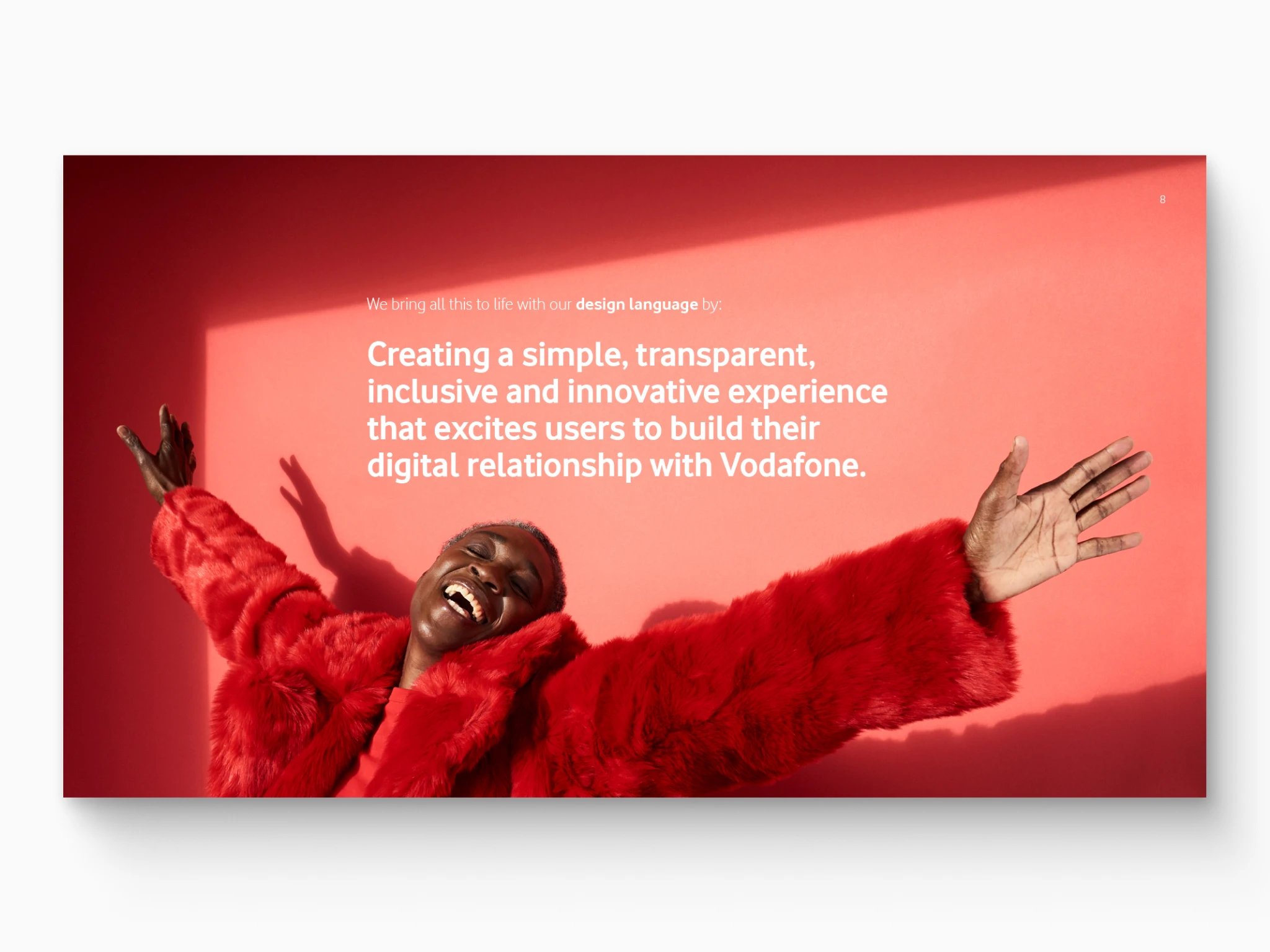
Design principles
Defining principles that laddered up to business goals
Introducing broad design principles that offer specific ways that design can directly contribute towards wider business goals. For example, for design to deliver against the customer experience principle to be straightforward; UI principles around clear structure, reducing clutter
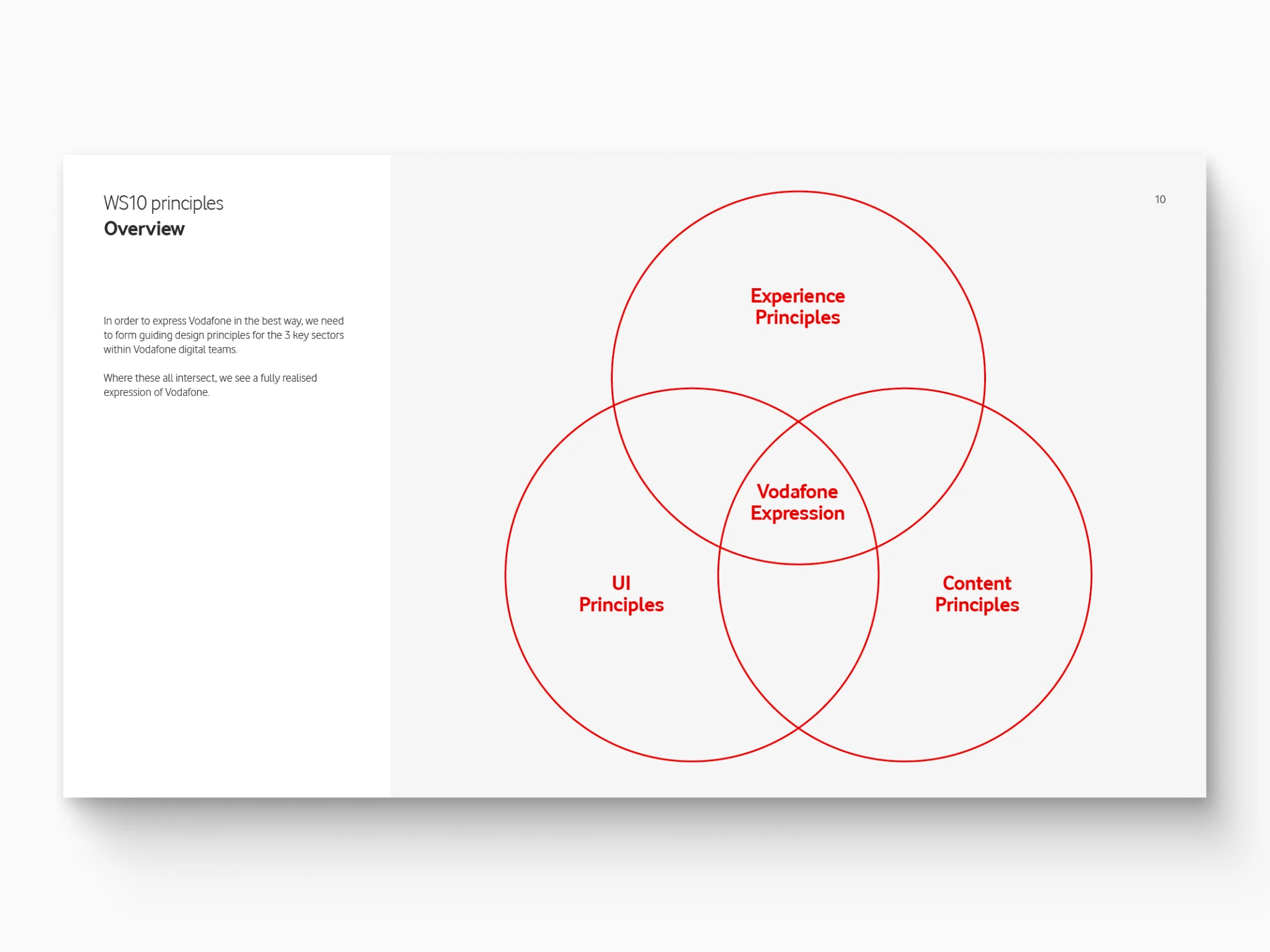
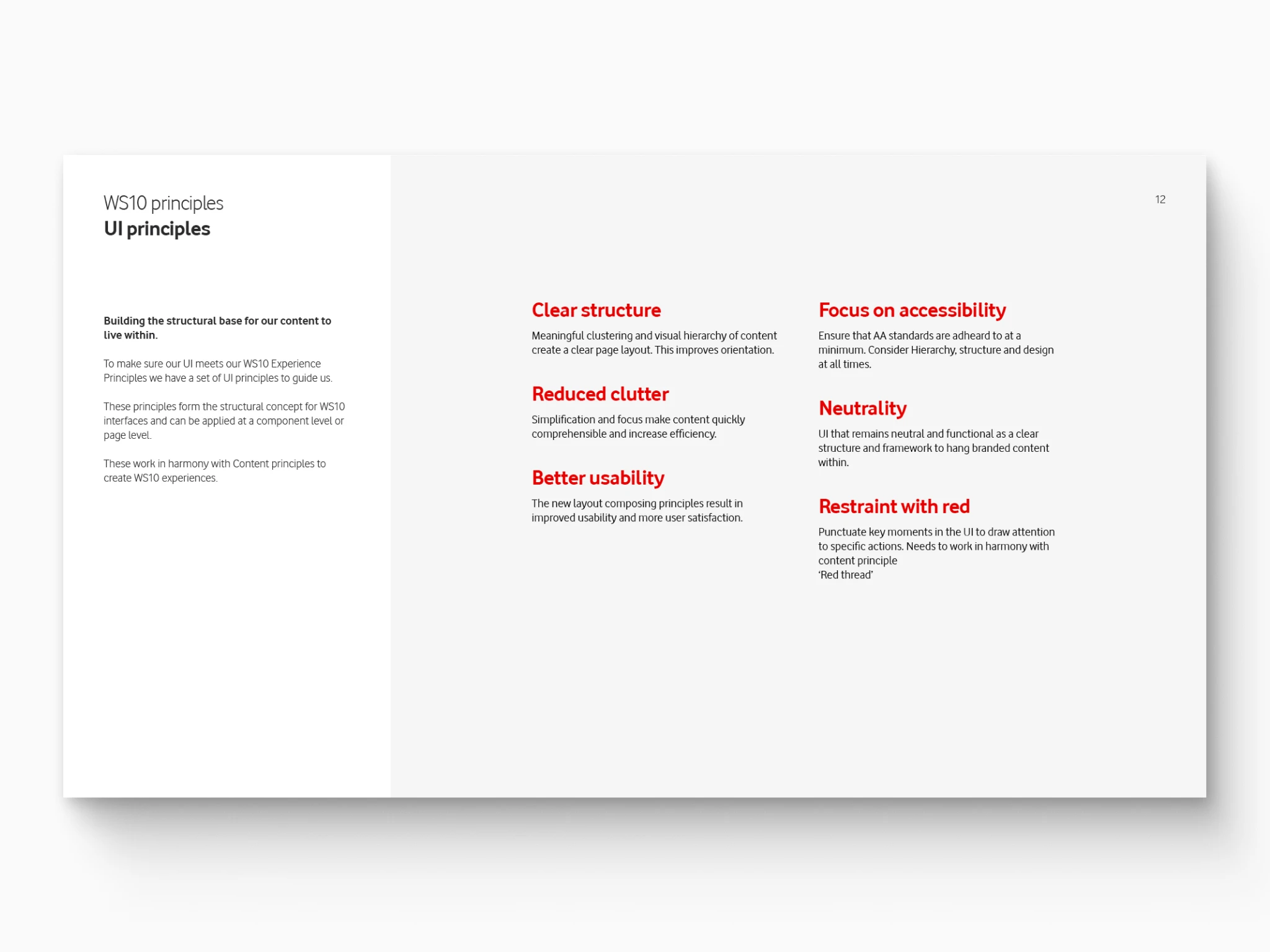
Design guidance
Established guidance to help teams implement the design principles
Visualised the principles with clearly illustrated guidance giving more context and building understanding without overwhelming with high-fidelity designs.
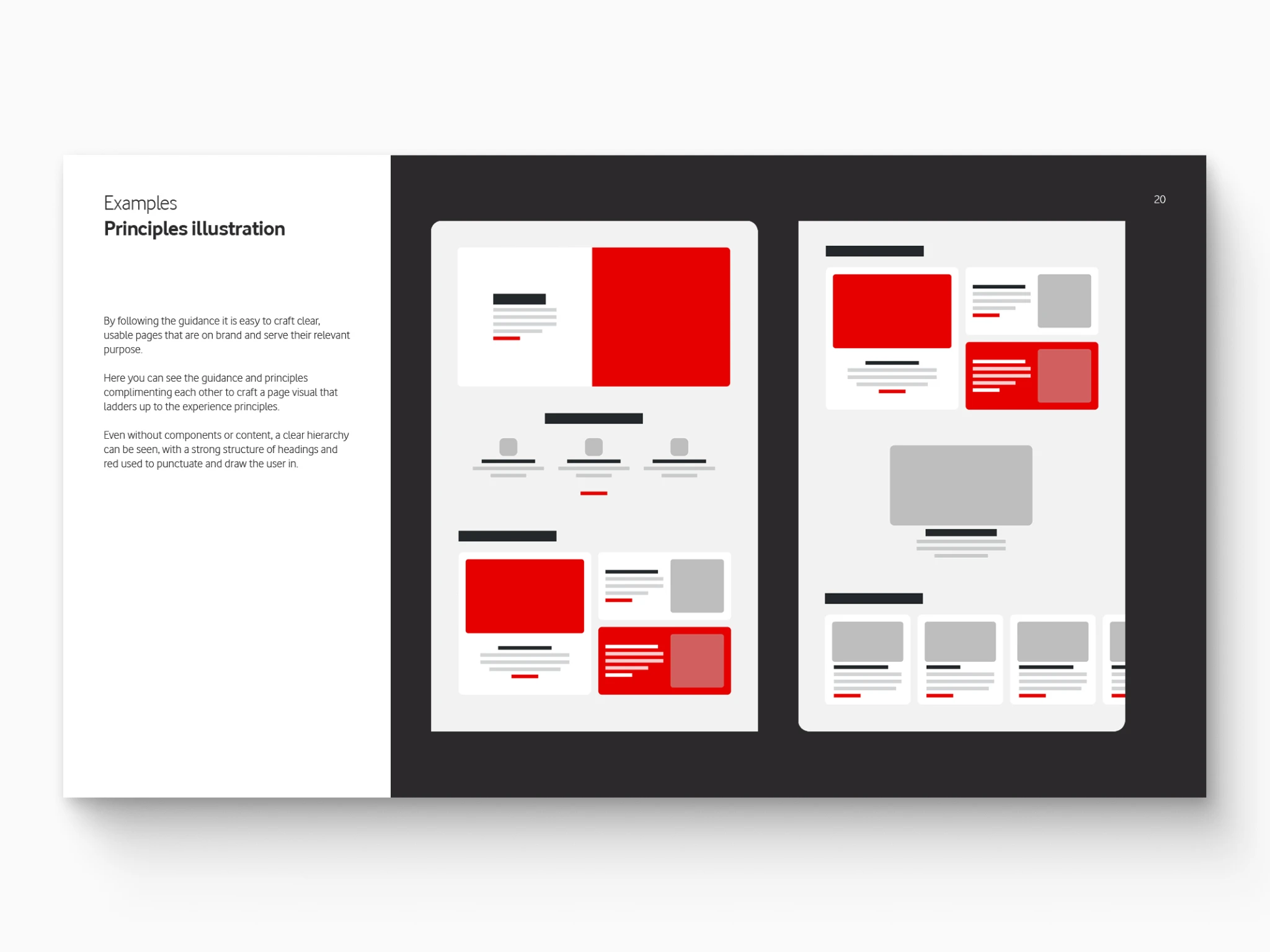
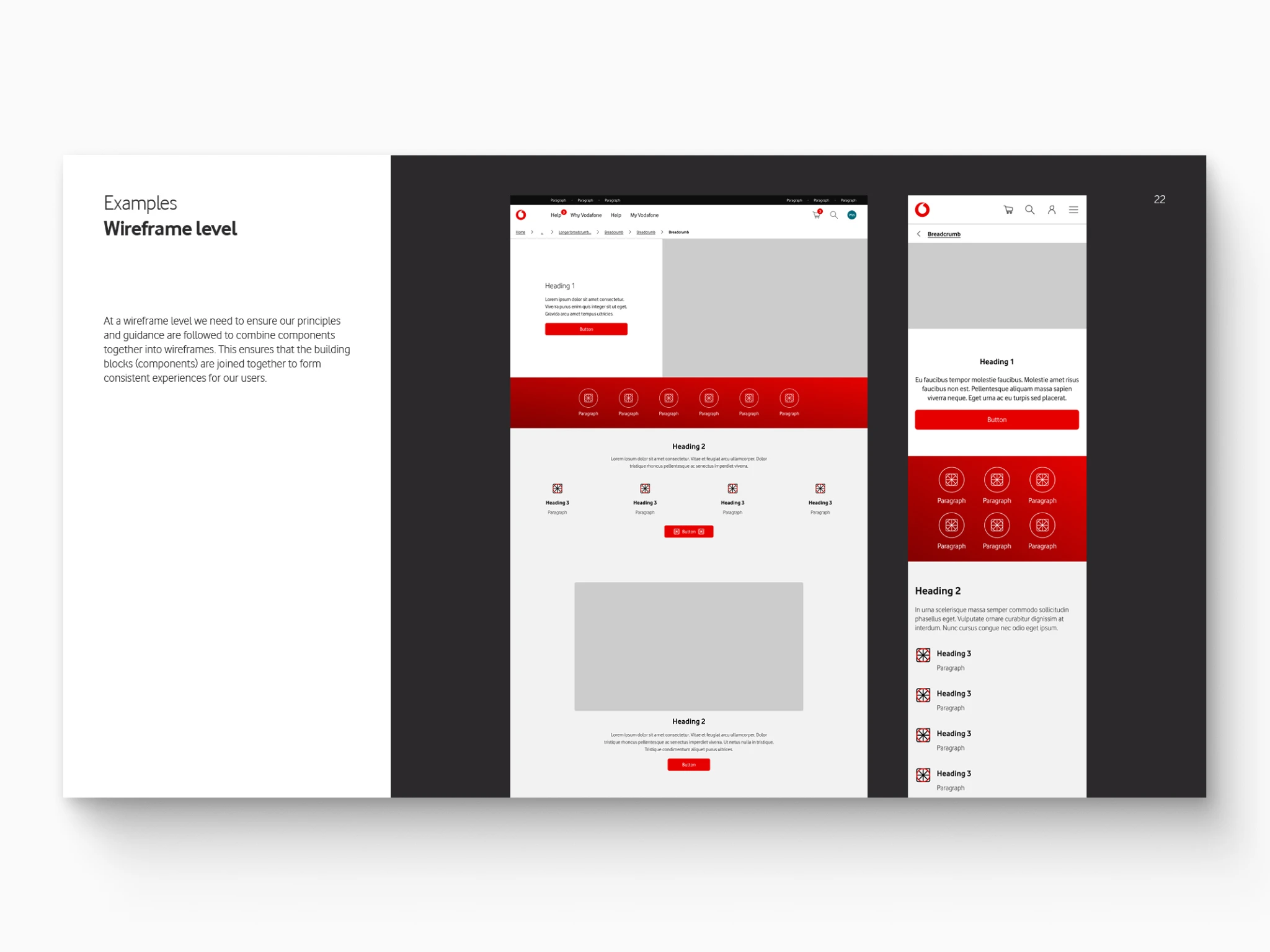
Design examples
Real world examples showing the design language in action
Brought the guidance to life with annotated real world examples; showing that following the guidance produces design that aligns to the design language principles, in turn helping to meet wider business objectives.
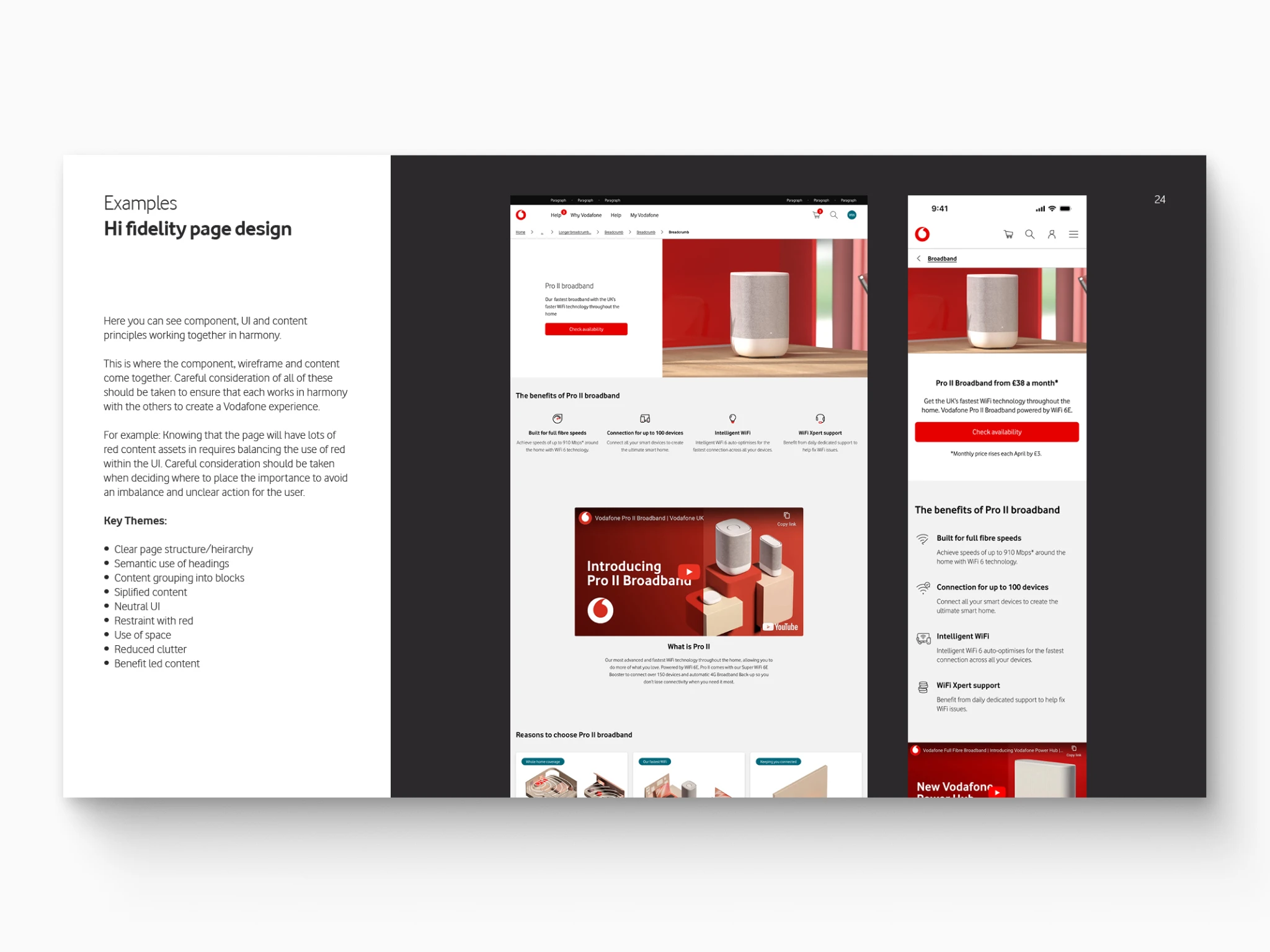
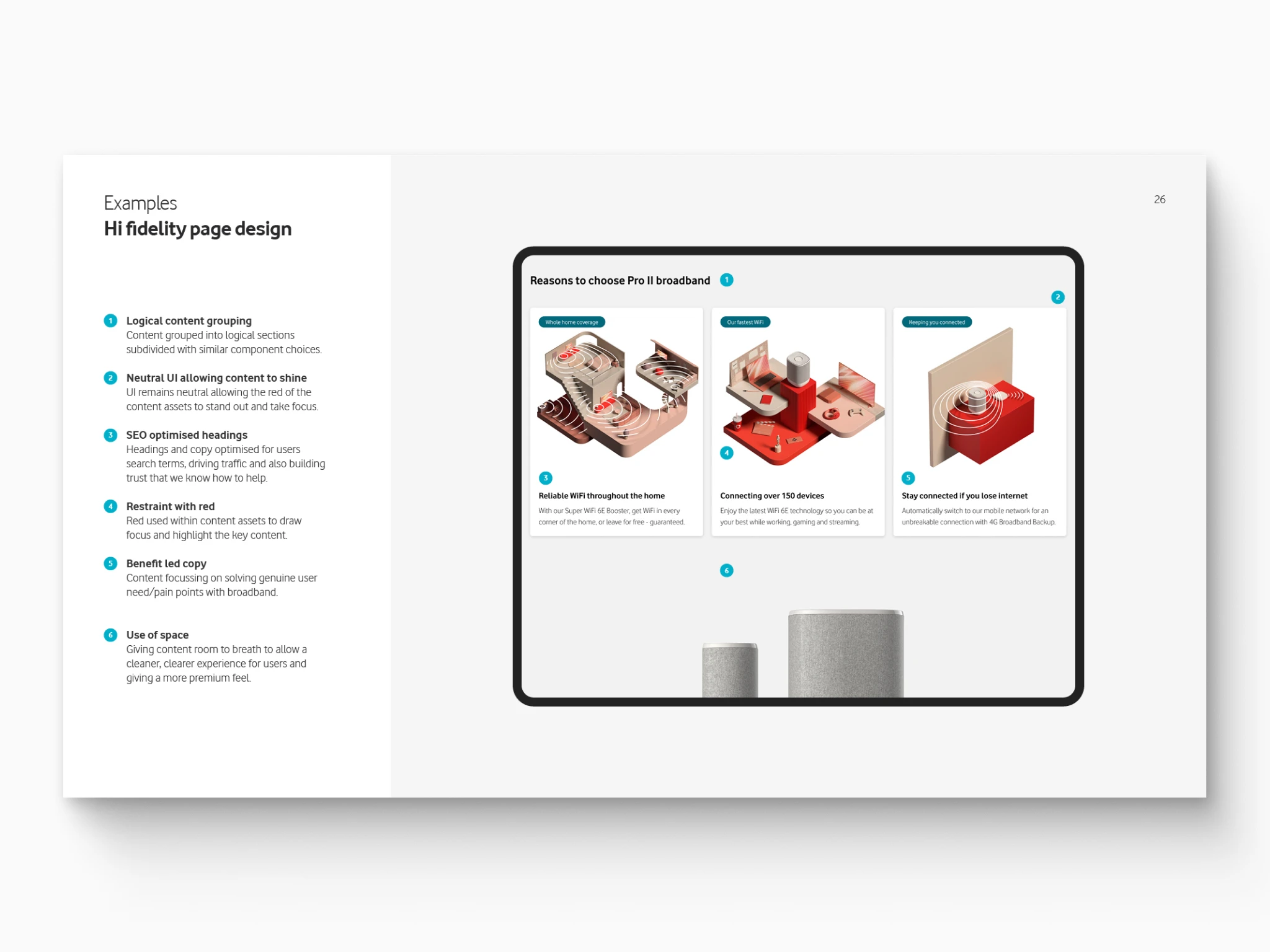
Take a look at the complete design language
See the design language
Validating the design language
I used the Vodafone Broadband Redesign to validate the design language. This ensured it was relevant and usable, and gained buy-in from outside the design community helping the whole project team align to the same vision.
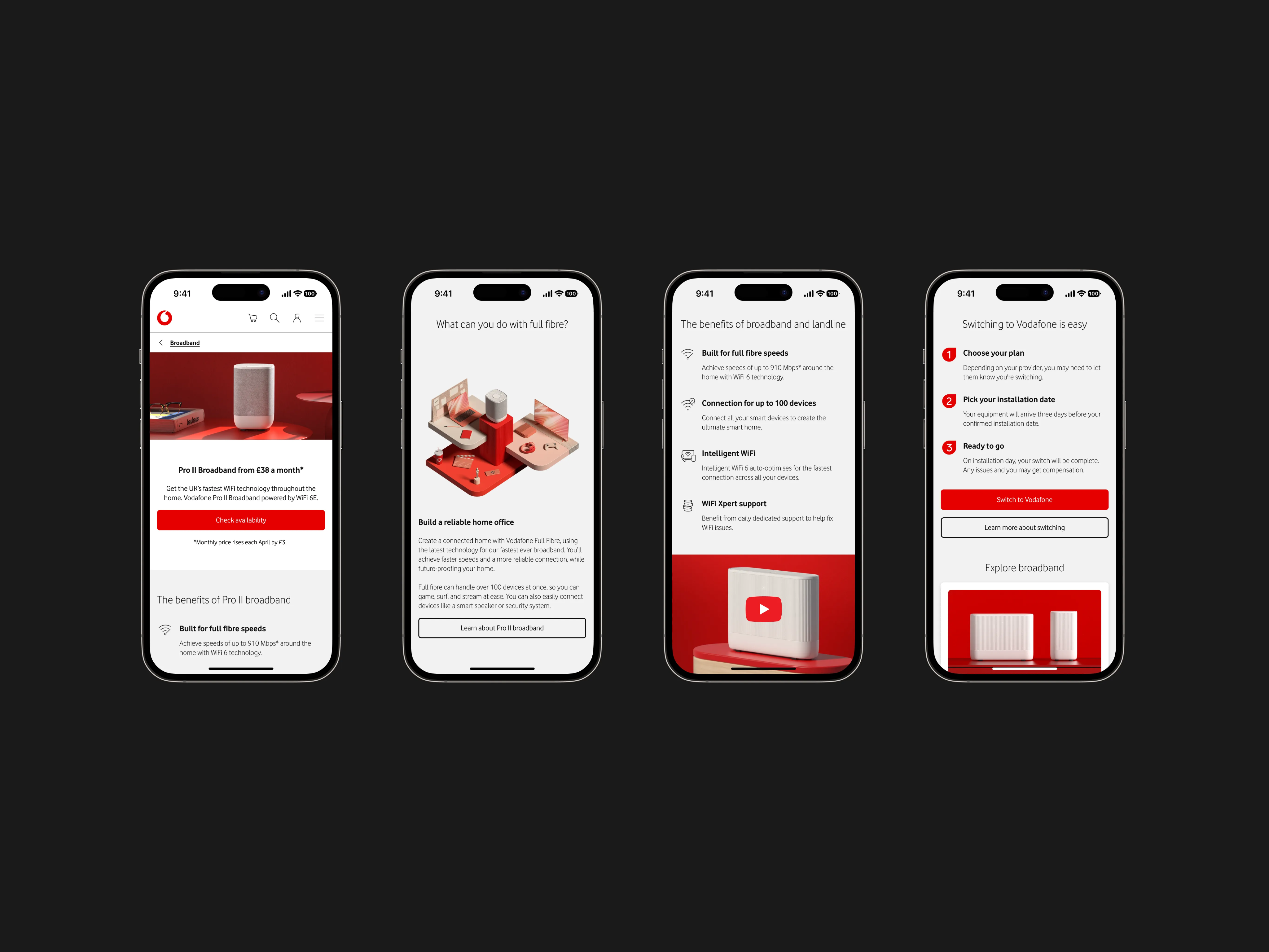
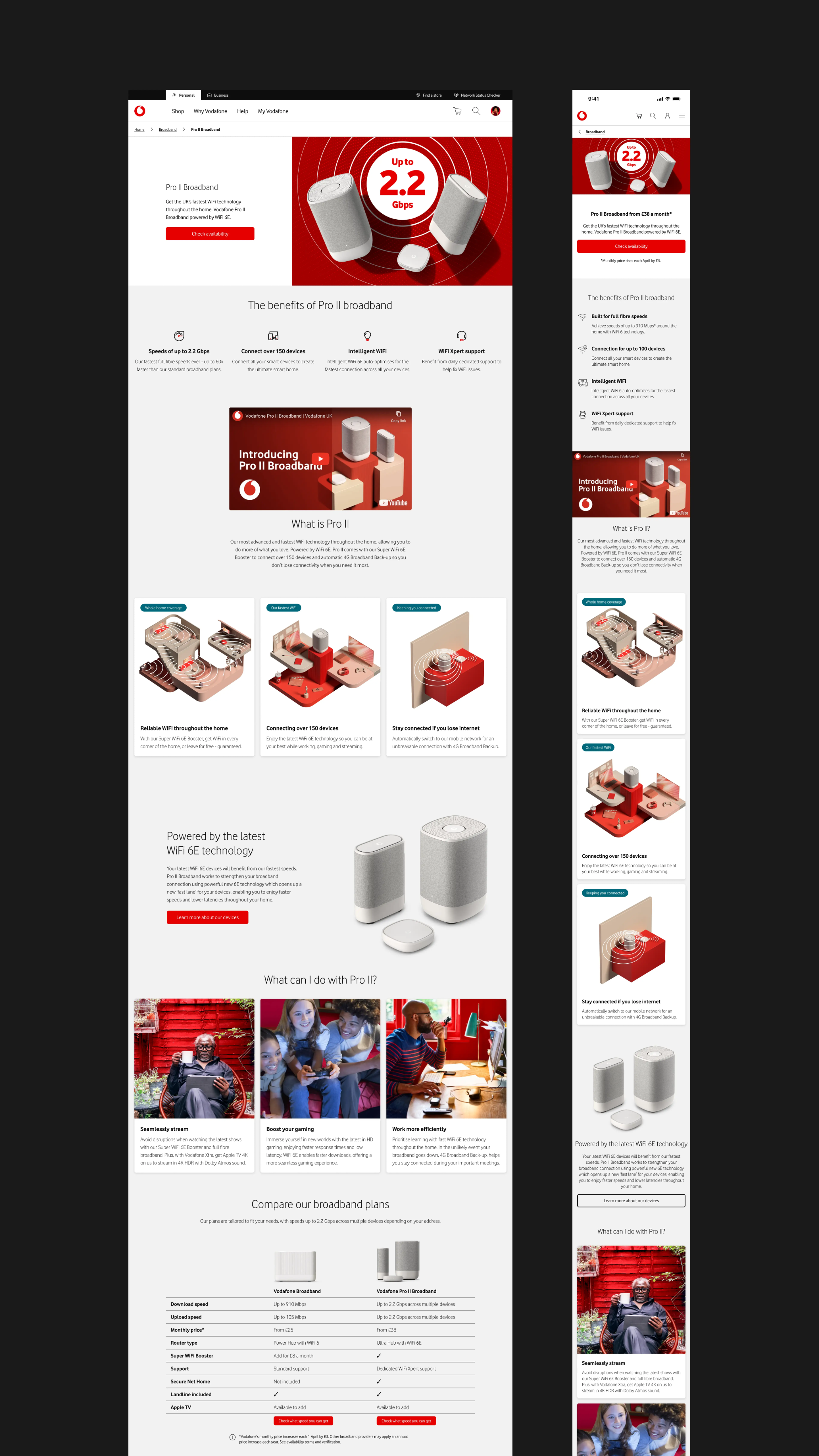
Outcomes
The design language became the foundation for driving consistent, brand-aligned digital experiences across Vodafone UK and, whilst still in it’s infancy, delivered against many of the goals.
Connection
Connected designers work directly to wider brand ambitions and goals making them relevant day-to-day.
Source of truth
Provided a single source of truth for design decisions with guidance to aid alignment.
Consistency
Brought consistency across teams when implementing the design system.
Buy-in
Support from non-designers in teams helped drive a greater sense of collaboration and working toward shared goals.
Improved metrics
Implementing the design language principles led to a +10.9% increase in basket progression within the broadband section.
Foundational for DesignOps
Adopted as the basis for DesignOps initiatives, highlighting relevance and scalability.
“Working with Edd at Vodafone has been exceptional. His design expertise truly shines in how he masterfully unified our brand elements into a comprehensive digital branding guide. By seamlessly integrating our reference designs, brand guidelines, and design system into one cohesive online resource, Edd created an invaluable tool for our team.”
M Smith
Design Systems Lead @ Vodafone
Edd Hopkinson
Senior Designer
© 2025 Edd Hopkinson
Edd Hopkinson
Senior Designer
Vodafone Design Language
Creating a foundational design framework to align design teams, improve design system alignment, and drive consistency.
Research
Strategy
Direction
Design System
Design
Guidance
Completed @ Vodafone

Outcomes
Integrated brand, UX/UI, and content into a single framework
Connected design to business goals
Source of truth for design decisions
Clear guidance for design system use
Improved design consistency across teams
Foundational for DesignOps inititives
Challenge
Vodafone UK inherited an incomplete design system with minimal documentation, poor digital guidance, and brand principles built primarily for print and above-the-line.
This led digital teams to implement the design system in their own ways, leading to inconsistent experiences and misaligned journeys.
Objectives
Define a cohesive design language to align design teams to a shared vision; bridging brand, strategy, UX/UI, and content into a consistent, scalable system.
Take a look at the complete design language
See the design language
Defining the vision
I collaborated with the Design Language team to develop a clear, actionable vision statement to act as a north star for decision making.
View the vision statement workshop

Setting goals
Goals were workshopped with UX/UI, Content Design, and Design System teams. These were refined into six goals that the design language needed to achieve to meet the project objectives.
See the goals workshop
Reference for design decisions
Help designers understand design decisions, ensuring consistency and coherence.
Seamless alignment across teams
Align all digital teams, streamlining workflows, and ensuring that everyone can apply the language with minimal training.
Identifying misalignment in designs
Users should be able to easily identify misalignment in their designs.
Specific and well-illustrated guidance
Clear, specific guidance with examples to gain confidence in decision making knowing that every step is well-supported.
Alignment of needs
Streamline the approval process by reducing conflicting component needs or competing priorities enabling faster delivery.
Consistency across platforms
By ensuring consistency we can impact key metrics such as click-through rates, conversion rates, and Net Promoter Score.
Research
I analysed existing brand strategies, employee goals, principles, guidelines, and documentation. This exposed gaps and misalignment; highlighting the lack of digital-specific guidance connecting brand, UX/UI, and content design.

Research insights:
Disconnected goals
Business goals seemed unrelated and unachievable to design roles. How could a designer help?
Poor brand integration
Design system lacked specific integration of brand principles and guidance.
Lack of awareness
Teams were not always aware of guidance or documentation, or where to go for help.
Poor brand guidance
Predominantly non-digital leading teams to form their own interpretation of the brand in digital.
Siloed teams
Teams were working in isolation, leading to inconsistent design patterns for customers.
Misalignment
Teams were free to use the design system unguided, leading to inconsistent experiences.
Creating the design language
Following the research phase I created a foundational design language to align design teams to a shared vision; bridging brand, strategy, UX/UI, and content into a consistent, scalable system.
The design language links four key areas together:
Business goals
Design principles
Design guidance
Design examples
Business goals
Brand, digital, and experience goals mapped into one framework
I consolidated brand ambition, digital mission, and experience principles to give design teams a clear view of how their digital specific team goals and work help achieve wider business and brand objectives — making wider objectives more relevant day-to-day and making them feel achievable.




Design principles
Defining principles that laddered up to business goals
Introducing broad design principles that offer specific ways that design can directly contribute towards wider business goals. For example, for design to deliver against the customer experience principle to be straightforward; UI principles around clear structure, reducing clutter


Design guidance
Established guidance to help teams implement the design principles
Visualised the principles with clearly illustrated guidance giving more context and building understanding without overwhelming with high-fidelity designs.


Design examples
Real world examples showing the design language in action
Brought the guidance to life with annotated real world examples; showing that following the guidance produces design that aligns to the design language principles, in turn helping to meet wider business objectives.


Take a look at the complete design language
See the design language
Validating the design language
I used the Vodafone Broadband Redesign to validate the design language. This ensured it was relevant and usable, and gained buy-in from outside the design community helping the whole project team align to the same vision.


Outcomes
The design language became the foundation for driving consistent, brand-aligned digital experiences across Vodafone UK and, whilst still in it’s infancy, delivered against many of the goals.
Connection
Connected designers work directly to wider brand ambitions and goals making them relevant day-to-day.
Source of truth
Provided a single source of truth for design decisions with guidance to aid alignment.
Consistency
Brought consistency across teams when implementing the design system.
Buy-in
Support from non-designers in teams helped drive a greater sense of collaboration and working toward shared goals.
Improved metrics
Implementing the design language principles led to a +10.9% increase in basket progression within the broadband section.
Foundational for DesignOps
Adopted as the basis for DesignOps initiatives, highlighting relevance and scalability.
“Working with Edd at Vodafone has been exceptional. His design expertise truly shines in how he masterfully unified our brand elements into a comprehensive digital branding guide. By seamlessly integrating our reference designs, brand guidelines, and design system into one cohesive online resource, Edd created an invaluable tool for our team.”
M Smith
Design Systems Lead @ Vodafone
Edd Hopkinson
Senior Designer
© 2025 Edd Hopkinson
Edd Hopkinson
Senior Designer
Vodafone Design Language
Creating a foundational design framework to align design teams, improve design system alignment, and drive consistency.
Research
Strategy
Direction
Design System
Design
Guidance
Completed @ Vodafone

Outcomes
Integrated brand, UX/UI, and content into a single framework
Connected design to business goals
Source of truth for design decisions
Clear guidance for design system use
Improved design consistency across teams
Foundational for DesignOps inititives
Challenge
Vodafone UK inherited an incomplete design system with minimal documentation, poor digital guidance, and brand principles built primarily for print and above-the-line.
This led digital teams to implement the design system in their own ways, leading to inconsistent experiences and misaligned journeys.
Objectives
Define a cohesive design language to align design teams to a shared vision; bridging brand, strategy, UX/UI, and content into a consistent, scalable system.
Take a look at the complete design language
See the design language
Defining the vision
I collaborated with the Design Language team to develop a clear, actionable vision statement to act as a north star for decision making.
View the vision statement workshop

Setting goals
Goals were workshopped with UX/UI, Content Design, and Design System teams. These were refined into six goals that the design language needed to achieve to meet the project objectives.
See the goals workshop
Reference for design decisions
Help designers understand design decisions, ensuring consistency and coherence.
Seamless alignment across teams
Align all digital teams, streamlining workflows, and ensuring that everyone can apply the language with minimal training.
Identifying misalignment in designs
Users should be able to easily identify misalignment in their designs.
Specific and well-illustrated guidance
Clear, specific guidance with examples to gain confidence in decision making knowing that every step is well-supported.
Alignment of needs
Streamline the approval process by reducing conflicting component needs or competing priorities enabling faster delivery.
Consistency across platforms
By ensuring consistency we can impact key metrics such as click-through rates, conversion rates, and Net Promoter Score.
Research
I analysed existing brand strategies, employee goals, principles, guidelines, and documentation. This exposed gaps and misalignment; highlighting the lack of digital-specific guidance connecting brand, UX/UI, and content design.

Research insights:
Disconnected goals
Business goals seemed unrelated and unachievable to design roles. How could a designer help?
Poor brand integration
Design system lacked specific integration of brand principles and guidance.
Lack of awareness
Teams were not always aware of guidance or documentation, or where to go for help.
Poor brand guidance
Predominantly non-digital leading teams to form their own interpretation of the brand in digital.
Siloed teams
Teams were working in isolation, leading to inconsistent design patterns for customers.
Misalignment
Teams were free to use the design system unguided, leading to inconsistent experiences.
Creating the design language
Following the research phase I created a foundational design language to align design teams to a shared vision; bridging brand, strategy, UX/UI, and content into a consistent, scalable system.
The design language links four key areas together:
Business goals
Design principles
Design guidance
Design examples
Business goals
Brand, digital, and experience goals mapped into one framework
I consolidated brand ambition, digital mission, and experience principles to give design teams a clear view of how their digital specific team goals and work help achieve wider business and brand objectives — making wider objectives more relevant day-to-day and making them feel achievable.




Design principles
Defined design principles to help teams meet business goals
Introducing broad design principles that offer specific ways that design can directly contribute towards wider business goals. For example, for design to deliver against the customer experience principle to be straightforward; UI principles around clear structure, reducing clutter


Design guidance
Established guidance to help teams implement the design principles
Visualised the principles with clearly illustrated guidance giving more context and building understanding without overwhelming with high-fidelity designs.


Design examples
Real world examples showing the design language in action
Brought the guidance to life with annotated real world examples; showing that following the guidance produces design that aligns to the design language principles, in turn helping to meet wider business objectives.


Take a look at the complete design language
See the design language
Validating the design language
I used the Vodafone Broadband Redesign to validate the design language. This ensured it was relevant and usable, and gained buy-in from outside the design community helping the whole project team align to the same vision.


Outcomes
The design language became the foundation for driving consistent, brand-aligned digital experiences across Vodafone UK and, whilst still in it’s infancy, delivered against many of the goals.
Connection
Connected designers work directly to wider brand ambitions and goals making them relevant day-to-day.
Source of truth
Provided a single source of truth for design decisions with guidance to aid alignment.
Consistency
Brought consistency across teams when implementing the design system.
Buy-in
Support from non-designers in teams helped drive a greater sense of collaboration and working toward shared goals.
Improved metrics
Implementing the design language principles led to a +10.9% increase in basket progression within the broadband section.
Foundational for DesignOps
Adopted as the basis for DesignOps initiatives, highlighting relevance and scalability.
“Working with Edd at Vodafone has been exceptional. His design expertise truly shines in how he masterfully unified our brand elements into a comprehensive digital branding guide. By seamlessly integrating our reference designs, brand guidelines, and design system into one cohesive online resource, Edd created an invaluable tool for our team.”
M Smith
Design Systems Lead @ Vodafone
Edd Hopkinson
Senior Designer
© 2025 Edd Hopkinson
Edd Hopkinson
Senior Designer
Vodafone Design Language
Creating a foundational design framework to align design teams, improve design system alignment, and drive consistency.
Research
Strategy
Direction
Design System
Design
Guidance
Completed @ Vodafone

Outcomes
Integrated brand, UX/UI, and content into a single framework
Connected design to business goals
Source of truth for design decisions
Clear guidance for design system use
Improved design consistency across teams
Foundational for DesignOps inititives
Challenge
Vodafone UK inherited an incomplete design system with minimal documentation, poor digital guidance, and brand principles built primarily for print and above-the-line.
This led digital teams to implement the design system in their own ways, leading to inconsistent experiences and misaligned journeys.
Objectives
Define a cohesive design language to align design teams to a shared vision; bridging brand, strategy, UX/UI, and content into a consistent, scalable system.
Take a look at the complete design language
See the design language
Defining the vision
I collaborated with the Design Language team to develop a clear, actionable vision statement to act as a north star for decision making.
View the vision statement workshop

Setting goals
Goals were workshopped with UX/UI, Content Design, and Design System teams. These were refined into six goals that the design language needed to achieve to meet the project objectives.
See the goals workshop
Reference for design decisions
Help designers understand design decisions, ensuring consistency and coherence.
Seamless alignment across teams
Align all digital teams, streamlining workflows, and ensuring that everyone can apply the language with minimal training.
Identifying misalignment in designs
Users should be able to easily identify misalignment in their designs.
Specific and well-illustrated guidance
Clear, specific guidance with examples to gain confidence in decision making knowing that every step is well-supported.
Alignment of needs
Streamline the approval process by reducing conflicting component needs or competing priorities enabling faster delivery.
Consistency across platforms
By ensuring consistency we can impact key metrics such as click-through rates, conversion rates, and Net Promoter Score.
Research
I analysed existing brand strategies, employee goals, principles, guidelines, and documentation. This exposed gaps and misalignment; highlighting the lack of digital-specific guidance connecting brand, UX/UI, and content design.

Research insights:
Disconnected goals
Business goals seemed unrelated and unachievable to design roles. How could a designer help?
Poor brand integration
Design system lacked specific integration of brand principles and guidance.
Lack of awareness
Teams were not always aware of guidance or documentation, or where to go for help.
Poor brand guidance
Predominantly non-digital leading teams to form their own interpretation of the brand in digital.
Siloed teams
Teams were working in isolation, leading to inconsistent design patterns for customers.
Misalignment
Teams were free to use the design system unguided, leading to inconsistent experiences.
Creating the design language
Following the research phase I created a foundational design language to align design teams to a shared vision; bridging brand, strategy, UX/UI, and content into a consistent, scalable system.
The design language links four key areas together:
Business goals
Design principles
Design guidance
Design examples
Business goals
Brand, digital, and experience goals mapped into one framework
I consolidated brand ambition, digital mission, and experience principles to give design teams a clear view of how their digital specific team goals and work help achieve wider business and brand objectives — making wider objectives more relevant day-to-day and making them feel achievable.




Design principles
Defined design principles to help teams meet business goals
Introducing broad design principles that offer specific ways that design can directly contribute towards wider business goals. For example, for design to deliver against the customer experience principle to be straightforward; UI principles around clear structure, reducing clutter


Design guidance
Established guidance to help teams implement the design principles
Visualised the principles with clearly illustrated guidance giving more context and building understanding without overwhelming with high-fidelity designs.


Design examples
Real world examples showing the design language in action
Brought the guidance to life with annotated real world examples; showing that following the guidance produces design that aligns to the design language principles, in turn helping to meet wider business objectives.


Take a look at the complete design language
See the design language
Validating the design language
I used the Vodafone Broadband Redesign to validate the design language. This ensured it was relevant and usable, and gained buy-in from outside the design community helping the whole project team align to the same vision.


Outcomes
The design language became the foundation for driving consistent, brand-aligned digital experiences across Vodafone UK and, whilst still in it’s infancy, delivered against many of the goals.
Connection
Connected designers work directly to wider brand ambitions and goals making them relevant day-to-day.
Source of truth
Provided a single source of truth for design decisions with guidance to aid alignment.
Consistency
Brought consistency across teams when implementing the design system.
Buy-in
Support from non-designers in teams helped drive a greater sense of collaboration and working toward shared goals.
Improved metrics
Implementing the design language principles led to a +10.9% increase in basket progression within the broadband section.
Foundational for DesignOps
Adopted as the basis for DesignOps initiatives, highlighting relevance and scalability.
“Working with Edd at Vodafone has been exceptional. His design expertise truly shines in how he masterfully unified our brand elements into a comprehensive digital branding guide. By seamlessly integrating our reference designs, brand guidelines, and design system into one cohesive online resource, Edd created an invaluable tool for our team.”
M Smith
Design Systems Lead @ Vodafone
Edd Hopkinson
Senior Designer
© 2025 Edd Hopkinson
Edd Hopkinson
Senior Designer
Vodafone Design Language
Creating a foundational design framework to align design teams, improve design system alignment, and drive consistency.
Research
Strategy
Direction
Design System
Design
Guidance
Completed @ Vodafone

Outcomes
Integrated brand, UX/UI, and content into a single framework
Connected design to business goals
Source of truth for design decisions
Clear guidance for design system use
Improved design consistency across teams
Foundational for DesignOps inititives
Challenge
Vodafone UK inherited an incomplete design system with minimal documentation, poor digital guidance, and brand principles built primarily for print and above-the-line.
This led digital teams to implement the design system in their own ways, leading to inconsistent experiences and misaligned journeys.
Objectives
Define a cohesive design language to align design teams to a shared vision; bridging brand, strategy, UX/UI, and content into a consistent, scalable system.
Take a look at the complete design language
See the design language
Defining the vision
I collaborated with the Design Language team to develop a clear, actionable vision statement to act as a north star for decision making.
View the vision statement workshop

Setting goals
Goals were workshopped with UX/UI, Content Design, and Design System teams. These were refined into six goals that the design language needed to achieve to meet the project objectives.
See the goals workshop
Reference for design decisions
Help designers understand design decisions, ensuring consistency and coherence.
Seamless alignment across teams
Align all digital teams, streamlining workflows, and ensuring that everyone can apply the language with minimal training.
Identifying misalignment in designs
Users should be able to easily identify misalignment in their designs.
Specific and well-illustrated guidance
Clear, specific guidance with examples to gain confidence in decision making knowing that every step is well-supported.
Alignment of needs
Streamline the approval process by reducing conflicting component needs or competing priorities enabling faster delivery.
Consistency across platforms
By ensuring consistency we can impact key metrics such as click-through rates, conversion rates, and Net Promoter Score.
Research
I analysed existing brand strategies, employee goals, principles, guidelines, and documentation. This exposed gaps and misalignment; highlighting the lack of digital-specific guidance connecting brand, UX/UI, and content design.

Research insights:
Disconnected goals
Business goals seemed unrelated and unachievable to design roles. How could a designer help?
Poor brand integration
Design system lacked specific integration of brand principles and guidance.
Lack of awareness
Teams were not always aware of guidance or documentation, or where to go for help.
Poor brand guidance
Predominantly non-digital leading teams to form their own interpretation of the brand in digital.
Siloed teams
Teams were working in isolation, leading to inconsistent design patterns for customers.
Misalignment
Teams were free to use the design system unguided, leading to inconsistent experiences.
Creating the design language
Following the research phase I created a foundational design language to align design teams to a shared vision; bridging brand, strategy, UX/UI, and content into a consistent, scalable system.
The design language links four key areas together:
Business goals
Design principles
Design guidance
Design examples
Business goals
Brand, digital, and experience goals mapped into one framework
I consolidated brand ambition, digital mission, and experience principles to give design teams a clear view of how their digital specific team goals and work help achieve wider business and brand objectives — making wider objectives more relevant day-to-day and making them feel achievable.




Design principles
Defined design principles to help teams meet business goals
Introduced broad design principles that offered specific ways that design can directly contribute towards wider business goals. For example, UI principles around clear structure, reducing clutter, and better usability help design to deliver against the customer experience principle to be straightforward.


Design guidance
Established guidance to help teams implement the design principles
Visualised the principles with clearly illustrated guidance giving more context and building understanding without overwhelming with high-fidelity designs.


Design examples
Real world examples showing the design language in action
Brought the guidance to life with annotated real world examples; showing that following the guidance produces design that aligns to the design language principles, in turn helping to meet wider business objectives.


Take a look at the complete design language
See the design language
Validating the design language
I used the Vodafone Broadband Redesign to validate the design language. This ensured it was relevant and usable, and gained buy-in from outside the design community helping the whole project team align to the same vision.


Outcomes
The design language became the foundation for driving consistent, brand-aligned digital experiences across Vodafone UK and, whilst still in it’s infancy, delivered against many of the goals.
Connection
Connected designers work directly to wider brand ambitions and goals making them relevant day-to-day.
Source of truth
Provided a single source of truth for design decisions with guidance to aid alignment.
Consistency
Brought consistency across teams when implementing the design system.
Buy-in
Support from non-designers in teams helped drive a greater sense of collaboration and working toward shared goals.
Improved metrics
Implementing the design language principles led to a +10.9% increase in basket progression within the broadband section.
Foundational for DesignOps
Adopted as the basis for DesignOps initiatives, highlighting relevance and scalability.
“Working with Edd at Vodafone has been exceptional. His design expertise truly shines in how he masterfully unified our brand elements into a comprehensive digital branding guide. By seamlessly integrating our reference designs, brand guidelines, and design system into one cohesive online resource, Edd created an invaluable tool for our team.”
M Smith
Design Systems Lead @ Vodafone
Edd Hopkinson
Senior Designer
© 2025 Edd Hopkinson